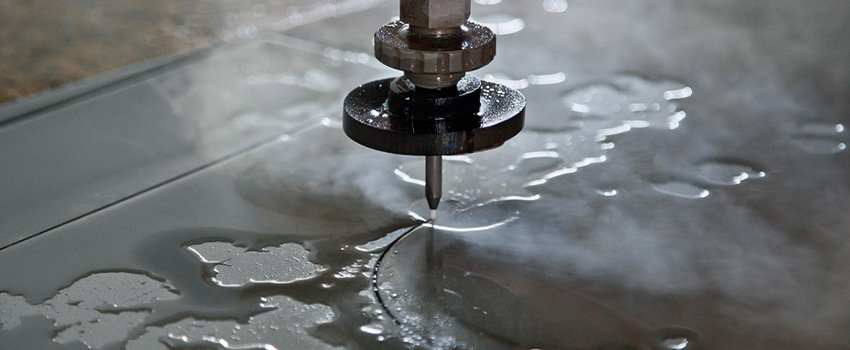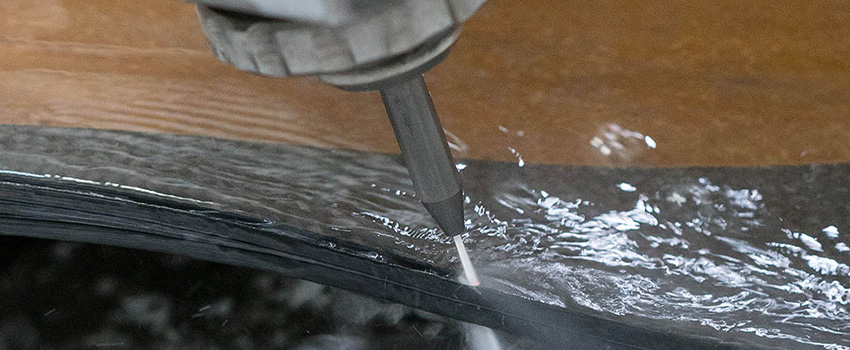
Mar 31, 2025 |
Waterjet Cutting Machine
Waterjet cutting is a versatile and precise cutting technology that uses a high-pressure jet of water, often mixed with abrasive particles, to cut through a wide range of materials. It is widely used in various industries because it is a cold cutting process, meaning it does not generate heat that can distort the material. Waterjet cutting can be applied to materials as diverse as metal, stone, glass, ceramics, plastics, and composites, making it a preferred choice for intricate and accurate cutting.
The process involves using a water jet stream pressurized to extremely high levels, typically around 60,000 psi (pounds per square inch), to cut through materials with a high degree of accuracy. When abrasive materials like garnet are added to the water jet, the cutting efficiency increases, enabling the system to cut through harder materials. The technology is highly effective in producing parts that require complex geometries and fine details with minimal kerf (cutting width) and little to no heat-affected zone.
Waterjet cutting offers several advantages, including the ability to cut materials that would otherwise be challenging for traditional methods like laser or plasma cutting, particularly materials that are sensitive to heat, such as titanium, glass, and composites. Additionally, waterjet cutting creates minimal waste due to its precision, and it does not produce harmful fumes or gases, making it an environmentally friendly process.
Waterjet cutting machines come in a variety of configurations to meet the diverse needs of different industries. Below are the major types of waterjet cutting machines:
A Multi Cutting Head Waterjet Cutting Machine features multiple cutting heads that can operate simultaneously or independently. This machine configuration allows for increased production speed and efficiency, particularly in applications where large volumes of cutting are required. For example, in industries such as aerospace or automotive manufacturing, where multiple parts are needed in a short time frame, the multi-cutting head machine can process several parts at once, significantly reducing production time.
The multi-cutting head design can also improve the flexibility of the operation. Operators can switch between different cutting heads to handle various materials, thicknesses, or cutting processes. This versatility is particularly useful in high-volume manufacturing environments.
CNC Waterjet Cutting Machine is among the most common types in use today. These machines rely on computer software to control the movement of the cutting head and the flow of the water jet. CNC technology allows for high precision and repeatability in cutting, making it suitable for industries that demand tight tolerances and intricate designs.
CNC waterjet cutting machines can be used with both water-only and abrasive jets, depending on the material and thickness being cut. The software allows operators to create complex patterns and designs, which the machine can execute automatically, reducing the need for manual intervention and ensuring high accuracy.
An Abrasive Waterjet Cutting Machine is a variation of the traditional waterjet cutting system, where abrasives (such as garnet) are added to the high-pressure water jet stream. This process enhances the cutting ability, allowing the machine to cut through harder materials such as metals, composites, and ceramics.
The addition of abrasive materials makes it a more versatile tool for a wide range of materials. The high-pressure stream combined with the abrasive particles creates a much stronger cutting force, allowing for more precise and faster cutting on tough materials compared to water-only cutting.
Abrasive waterjet cutting machines are commonly used in industries like aerospace, automotive, and heavy manufacturing, where precision and the ability to cut through tough materials are essential.
Gantry Type Waterjet Cutting Machine features a robust frame design where the cutting head moves along an overhead gantry structure. This type of machine is suitable for cutting larger materials or for applications that require a high level of rigidity to avoid distortion during cutting. The gantry structure allows for precise control of the cutting head's movement, enabling high-quality cuts on large, flat sheets of material.
Gantry waterjet machines are ideal for heavy-duty applications, particularly in industries such as shipbuilding, metal fabrication, and structural engineering. The design offers a large cutting area, which is beneficial for manufacturers who need to process large plates or sheets in a single pass.
The Standard Abrasive Waterjet Cutting Machine is designed specifically for cutting tough materials using a mix of high-pressure water jet and abrasives. This machine is commonly used for industrial applications where cutting steel, aluminum, titanium, or stone is required. By mixing the abrasives with water, the cutting process becomes more effective at penetrating hard surfaces.
These machines are designed to deliver a high volume of water jet pressure combined with abrasives to cut through materials with a high level of precision. It is highly preferred for high-precision cutting needs where heat-sensitive materials are involved, and it is versatile enough to handle a wide range of material types and thicknesses.
Waterjet systems operate using high-pressure water, which is directed through a small nozzle to cut through materials. The basic operation of a waterjet cutting system consists of the following main components:
High-Pressure Pump: The pump is responsible for pressurizing the water jet to extremely high levels, typically 60,000 psi or more. This pump can be powered by hydraulic, electric, or direct-drive mechanisms, depending on the specific system design.
Abrasive Mixing Tube: In systems that use abrasives, the abrasive mixing tube combines the high-pressure water jet with abrasive particles like garnet, creating a powerful cutting stream.
Cutting Head and Nozzle: The cutting head houses the nozzle, where the pressurized water jet stream is released. The nozzle’s design helps to concentrate the water flow, allowing it to cut through the material efficiently.
CNC Controller: For CNC systems, the controller guides the movement of the cutting head according to the design instructions fed from a computer. This ensures that the cutting path is followed with high precision.
Material and Table: The material to be cut is placed on a table designed to support it while the waterjet cuts through it. Some waterjet systems are equipped with a water table to capture the cut material and prevent excess debris or splashing.
Waterjet Cutter works by focusing the water jet at a specific location on the material surface. The force from the water jet cuts through the material, while the CNC system ensures that the head follows the programmed path. This allows the system to cut intricate patterns and designs with great accuracy and precision.

The power of the nozzle plays a critical role in determining the efficiency and effectiveness of the waterjet cutting process. The nozzle's size, shape, and configuration directly influence the cutting performance, precision, and material compatibility.
Size of the Nozzle: The size of the nozzle determines how concentrated the water jet flow is. A smaller nozzle can produce a finer, more precise cut, while a larger nozzle might be used for cutting thicker materials. The size of the nozzle should match the application and the material thickness to optimize cutting speed and accuracy.
Material of the Nozzle: Nozzles are typically made from durable materials such as carbide or diamond, as they must withstand the intense pressure and abrasive forces encountered during the cutting process. These materials ensure longevity and minimal wear on the nozzle.
Nozzle Configuration: Different configurations of nozzles can be used for specific tasks, such as focusing on a narrow or wide cutting path. Some nozzles may also allow for adjustments in water jet pressure to accommodate different types of materials or cutting speeds.
The nozzle is a crucial element because it determines how efficiently the cutting stream is focused and directed. A well-designed nozzle ensures that the water or abrasive mixture is delivered at the right pressure and angle to produce a clean and accurate cut.
Waterjet cutting, often referred to as "cold cutting," offers numerous benefits compared to traditional cutting methods, such as laser, plasma, or mechanical cutting. Here are some key advantages:
Unlike cutting methods that involve heat, such as laser or plasma cutting, waterjet cutting does not generate heat. This results in a lack of a heat-affected zone (HAZ), which can cause material warping, discoloration, or structural changes. The ability to cut materials without heat makes waterjet cutting particularly valuable for heat-sensitive materials like plastics, rubber, and metals.
Waterjet cutting can handle a wide range of materials, from soft materials like rubber to hard materials like metals and ceramics. It can also cut through a variety of thicknesses, making it highly versatile in industrial applications.
Waterjet cutting provides high precision with tight tolerances. CNC-controlled systems ensure that intricate designs and detailed patterns can be achieved with minimal deviation. This level of accuracy is crucial in industries that require high-quality components with exact specifications.
Waterjet Cutting Machine creates minimal material waste compared to other cutting methods. The precision of the process ensures that materials are used efficiently, reducing scrap and lowering production costs.
Waterjet cutting uses water and abrasives, creating fewer emissions and byproducts compared to cutting processes like laser or plasma cutting. It does not produce harmful fumes or gases, which helps to improve workplace safety and reduce environmental impact.
When choosing a waterjet cutting service, it's essential to partner with a company that understands the nuances of the technology and can provide high-quality results. Our company offers state-of-the-art waterjet cutting services with advanced equipment and skilled operators. We ensure that all projects are completed with precision, efficiency, and minimal waste. Whether you're in aerospace, manufacturing, or architecture, our waterjet cutting services provide the ideal solution for your needs.
In engineering, waterjet cutting plays a crucial role in creating precise components for machinery, automotive parts, and structural elements. The ability to cut through a variety of materials without affecting the material's integrity or structure makes it an indispensable tool in this field.
In manufacturing, particularly in industries like aerospace and automotive, waterjet cutting is used to produce parts with intricate designs and high tolerances. It helps streamline the production process, reduces waste, and ensures high-quality finished products.
Waterjet cutting is also gaining prominence in architecture and commercial industries for creating custom designs in materials such as stone, metal, and glass. Whether it’s intricate patterns for facades or custom-cut pieces for interior designs, waterjet technology enables architects and designers to achieve creative and precise solutions.
Waterjet cutting is a highly efficient, precise, and versatile method for cutting a wide variety of materials. With applications across multiple industries, from engineering to architecture, waterjet cutting offers numerous benefits, including the ability to cut materials without heat distortion, minimal waste, and high precision. The different types of waterjet machines, such as multi-cutting head machines, CNC-controlled systems, and abrasive waterjets, offer flexibility and speed for a range of applications.
As industries continue to evolve, waterjet cutting remains a critical technology, offering the potential for faster production cycles, cost savings, and the ability to tackle complex cutting challenges. By choosing a reliable and experienced waterjet cutting service, you can ensure that your projects are completed with the highest level of precision and efficiency.
Waterjet Cutting Machine, Waterjet Cutting Machine, Water Jet Cutter, Water Jet Application, Waterjet Cutting Machine Process, Water Jet, Waterjet, Waterjet Cutter, Water Cut, Water Cutting, Abrasive Jet, Cold Cutting Process, Waterjet Cutter Machine, Waterjet Cutting Machine Solutions, Waterjet Machines, Waterjet Solutions, Abrasive Waterjet, Waterjet Technology, Advanced Waterjet Technology, Abrasive Waterjet Cutting Machine, Waterjet Systems, Water Jet Cutting, Waterjet Mobile, Waterjet Machine, Cnc Controlled Portable Waterjet, Cnc Portable Waterjet Cut Pipe, Waterjet Cutting Machine Service, Water Jet Cutting Service
We provide innovative product solutions for sustainable progress. Our professional team works to increase productivity and cost effectiveness on the market.